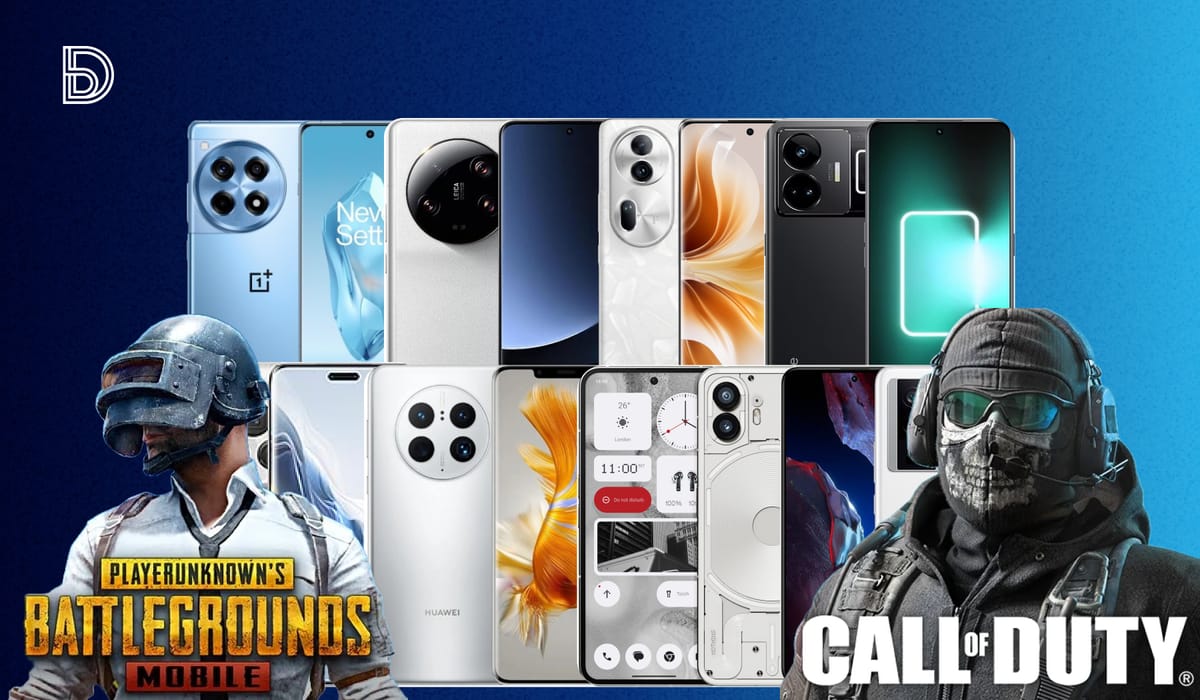Play PUBG and CODM on these Non-Gaming smartphones right now
Yup, mobile phones for gamers who have lives outside of gaming.

Most people agree that if you want to truly enjoy gaming, you should opt for a device built for the job, whether it's a dedicated gaming phone, PC, or console.
It's easy to see why—these devices let you tweak settings for better graphics, sound, and response times, making them perfect for intense gaming without overheating. And, they often come with cool extras like virtual controller buttons.
But the reality is, mobile gaming has evolved into a powerhouse in the gaming industry, accounting for over half of total video game revenue. With games like PUBG Mobile and CODM leading the charge in Africa, mobile gaming is no longer a second-tier option; it’s the main event.
Per Newzoo, the majority of gamers in the region are now playing on smartphones or tablets, driven by rising smartphone ownership, better internet access, and a young, energetic population.
If you're looking for all-rounder smartphones that strike the perfect balance between gaming capability and everyday use, keep reading.
How we chose the best Non-Gaming Smartphones for Gaming
Here’s a breakdown of our selection process:
- Processor: We went for devices with Snapdragon 8 Gen 2 or higher, or a Cortex X5. These processors ensure top-tier performance and offer the quick response times you need for gaming.
- Battery Life: While a bigger battery doesn't always guarantee longer life, a 4500mAh battery or larger was non-negotiable, ensuring extended play without the constant need for recharging.
Check this guide out if you’re curious about the best long-lasting battery phones in 2024.
- VR Capabilities: High frame rates (90Hz or 120Hz) were essential. Anything less than 60fps won’t cut it for VR, so we picked phones that support higher frame rates to reduce motion blur and latency.
- Display Design: We chose phones with minimal chin, thin bezels, and either a punch-hole or waterdrop notch to maximise the display area. This is to minimise distractions and enhance immersion during gameplay, especially in landscape mode.
- Sound System: A top-notch sound system was a must. The phones we picked deliver rich, clear audio, crucial for a full gaming experience.
- Cooling System: Effective cooling systems were key. We avoided devices like iPhones that tend to overheat, focusing instead on phones that maintain performance and comfort during extended gaming sessions.
- Non-Exynos Chipset: We also steered clear of Exynos processors, which are known for overheating and power inefficiency. Snapdragon-powered devices are generally favoured for their consistent gaming performance.
- Storage and RAM: Each phone had to have at least 8GB of RAM and fast storage (UFS 3.1 or higher) to handle smooth multitasking and quick load times.
Now to the order of the day.
The 8 Best Non-Gaming Smartphones for Gaming
These phones are available on official sites, Slot, Jumia, and other e-retailers. Here are the starting prices and a quick list.
1. OnePlus 12R - ₦850,000 / $527
2. Xiaomi Mi 13 Ultra - ₦950,000 / $589
3. Oppo Reno 11 Pro 5G - ₦590,000 / $366
4. Realme GT 3 - ₦480,320 / $298
5 Honor Magic 6 Pro - ₦1,800,000 / $1,116
6. Huawei Mate 50 Pro - ₦900,000 / $558
7. Nothing Phone 2 - ₦950,000 / $589
8. Xiaomi Poco F5 Pro 5G - ₦650,000 / $403
OnePlus 12R

Processor: Snapdragon 8 Gen 2 | Battery: 5500mAh, 80W | Display: 6.78-inch AMOLED, 120Hz | Cooling System: Dual Cryo-velocity VC Cooling System | Storage: 128GB/256GB UFS 3.1 | Sound System: Dual stereo speakers
The OnePlus 12R is a strong gaming option with its Snapdragon 8 Gen 2 chipset, outperforming many non-gaming phones and rivalling pricier models like the Galaxy S23. It features a bright, durable display with Gorilla Glass Victus 2, making it suitable for gaming even outdoors.
The Cryo-Velocity cooling system keeps the phone cool during intense gaming, and the battery holds up well under heavy use. Oxygen OS 14 provides a clean, up-to-date Android experience, though software support is limited to three years.
The dual speakers deliver clear, directional sound, enhancing the gaming experience.
Pros:
- Display is brilliant
- Smooth performance and good gaming performance
- Good main camera
- Solid build with metal frame
- Long battery life with 100W fast charging
Cons:
- No telephoto camera
- Average video quality and stabilisation
Xiaomi Mi 13 Ultra
Processor: Snapdragon 8 Gen 2 | Battery: 5000mAh, 90W | Display: 6.73-inch LTPO AMOLED, 120Hz | Cooling System: Advanced cooling technology | Storage: 256GB/512GB/1TB UFS 4.0 | Sound System: Stereo speaker
Xiaomi 13 Ultra is a gaming powerhouse, driven by Qualcomm’s Snapdragon 8 Gen 2 processor and up to 16GB of RAM, ensuring beastly performance during intense gaming sessions.
The 6.73-inch AMOLED display, with its 120Hz refresh rate and WQHD+ resolution, offers vibrant visuals and smooth gameplay, even under direct sunlight.
With a 5,000mAh battery, it easily lasts through extended gaming, with fast 90W wired charging getting you back in action in just 35 minutes.
Advanced cooling keeps the phone cool during long sessions, while the powerful camera system and precise colour accuracy add to its appeal.
Pros:
- Quad 50 MP cameras with tons of settings
- Top-quality display
- Top-notch thermal handling
- Rapid charging
- Dolby Vision and Dolby Atmos support
Cons:
- No US/UK availability
- Bulky design
- Selfie camera is subpar
Oppo Reno 11 Pro 5G
Processor: MediaTek Dimensity 8200 | Battery: 4600mAh, 80W | Display: 6.7-inch AMOLED, 120Hz | Cooling System: Effective thermal management | Storage: 256GB/512GB UFS 3.1 | Sound System: Single loudspeaker
Not quite up to standard compared to the first two but the Oppo Reno 11 Pro 5G has a lot to offer. The slightly reflective screen might distract during intense gaming, but the HDR10 support ensures vivid, immersive visuals. The 6.7-inch 1080p OLED display delivers punchy colours, deep blacks, and an adaptive 120Hz refresh rate for smooth transitions.
Powered by the MediaTek Dimensity 8200, the phone handles daily tasks and casual gaming well, though it shows limits with graphic-intensive games. With 256GB of storage and 12GB of RAM, performance remains smooth, even in games like PUBG and Asphalt 9.
In CODM, the Dimensity 8200 struggles to maintain a stable 60fps at maxed-out settings, but the gameplay remains smooth and enjoyable.
There is no mention of a cooling solution, so the device does warm up during extended sessions, but ColorOS 14 enhances the experience with smart features and long-term updates.
Pros:
- Smart Touch Function
- Ultra-narrow bezels
- 120Hz curved AMOLED display
- Smooth performance
- Android 14 out of the box with 3 more Android updates
- Good battery life, 80W fast charging
Cons:
- Limited Gestures
- Pre-installed bloatware
- No stereo speakers
Realme GT 3
Processor: Snapdragon 8+ Gen 1 | Battery: 4600mAh, 240W | Display: 6.74-inch AMOLED, 144Hz | Cooling System: Advanced cooling system | Storage: 128GB/256GB/512GB/1TB UFS 3.1 | Sound System: Stereo speakers
The Realme GT 3 has a 6.74-inch AMOLED display with a resolution of 2772 x 1250, so everything looks sharp and clear, even in bright sunlight. The screen is also super responsive, thanks to its 360Hz touch sampling rate. You can adjust the refresh rate up to 144Hz, which keeps things smooth whether you’re scrolling or gaming.
Powered by the Snapdragon 8+ Gen 1 chipset, it delivers strong performance, and with configurations of up to 16GB RAM and 1TB storage, it handles demanding tasks with ease. The stereo speakers are loud and clear, though bass is a bit limited. Gaming on the GT 3 is smooth, with titles like CODM and Genshin Impact running well on medium settings, though the phone heats up during longer sessions.
A key feature is the ultra-fast charging, fully powering the 4600mAh battery from zero to full in just 11 minutes, though the battery itself offers about a day of use with average activity. The newer Realme GT 6, released in May, is also worth considering. It promises improved optimization and thermal management on paper and there's not enough real-world performance yet.
Pros:
- 240W charging juices the phone in around ten minutes
- Bright and bold 144Hz display
- Decent performance
Cons:
- Average battery life
- Some overheating issues
- Very limited water resistance
Honor Magic 6 Pro
Processor: Snapdragon 8 Gen 3 | Battery: 5600mAh, 80W, 66W wireless | Display: 6.8-inch LTPO OLED, 120Hz | Cooling System: Advanced cooling technology | Storage: 256GB/512GB/1TB UFS 4.0 | Sound System: Hybrid stereo speaker
Honor, once known for budget smartphones, has shifted focus to high-end devices, and the Magic 6 Pro is a prime example. Its design grabs attention with a large rear camera module, though it may feel awkward in landscape mode.
The Magic 6 Pro’s 6.8-inch All-range Low-power LTPO Eye Comfort Display offers vibrant colours and sharp resolution at 2800×1280 pixels. With a peak brightness of 5000 nits, the display remains clear even in direct sunlight, and Dolby Vision enhances the HDR viewing experience.
Performance-wise, the Magic 6 Pro keeps up with flagship devices though extended 4K video recording or gaming sessions can cause noticeable warmth. However, turning off Performance Mode can help manage this without sacrificing much speed.
Pros:
- Excellent Cameras
- Top-tier performance
- Stunning 120Hz screen
- Very good battery life
Cons:
- Underwhelming ultrawide camera
- Cluttered software
- Expensive
Huawe Mate 50 Pro
Processor: Snapdragon 8+ Gen 1 | Battery: 4700mAh, 66W | Display: 6.7-inch LTPO OLED, 120Hz | Cooling System: Advanced cooling technology | Storage: 256GB/512GB UFS 3.1 | Sound System: Stereo speakers
The Mate 50 Pro, with its Snapdragon 8+ Gen 1 chip and 8GB of RAM, delivers impressive performance, outperforming the older P50 Pro with its Snapdragon 888. It handles high-end games like PUBG Mobile smoothly, as shown by its strong Geekbench 5 scores.
Its 4700mAh battery offers notably longer life than the P50 Pro’s 4360mAh, lasting almost 16 hours on a single charge. You can charge it quickly with 66W wired, 50W wireless, and 7.5W reverse wireless options. Plus, the new Low-Battery Emergency Mode helps extend usage even when the battery gets really low.
The phone’s dual speakers provide rich sound, but it doesn’t have a 3.5mm jack. The 6.74-inch OLED display is impressive, featuring a 120Hz refresh rate, HDR10+ support, and plenty of customisation options for resolution, refresh rate, and colour settings, ensuring a better gaming experience.
Pros:
- Solid build quality
- Excellent 120Hz OLED screen
- Innovative camera system
- High-end chipset delivers good performance
- IP68 dust/water resistance
Cons:
- No native Google support
- No 5G
- Durable Kunlun glass on Orange version only
- Quite Pricey
Nothing Phone 2
Processor: Snapdragon 8+ Gen 1 | Battery: 4700mAh, 45W | Display: 6.7-inch OLED, 120Hz | Cooling System: Advanced cooling system | Storage: 128GB/256GB/512GB UFS 3.1 | Sound System: Stereo speakers
The Nothing Phone (2) definitely turns heads with its eye-catching design. It has a sturdy aluminium frame complete with LED ‘glyph’ light strips that flash for notifications and other alerts. The updated light layout includes six segmented strips and split camera lights, adding a touch of flair.
Powered by the Snapdragon 8+ Gen 1 chipset, the Phone (2) delivers a standard performance for everyday tasks and games like Call of Duty Mobile. It’s not the latest Snapdragon 8 Gen 2, but it handles most activities smoothly.
Phone (2) offers a range of configurations, including options with 8GB of RAM and 128GB of storage, or higher-end models with up to 12GB of RAM and 512GB of storage. Note that it does not have a microSD slot but supports dual SIM cards.
Its 6.7-inch OLED display features a 120Hz refresh rate and LTPO technology for efficient battery use. However, it has difficulty achieving high brightness levels outdoors, even at maximum settings, though it performs better indoors with brightness up to 1,600 nits. The dual stereo speakers deliver good sound for gaming and media, though they may sound a bit thin for music at higher volumes.
Pros:
- Premium build
- Excellent Android skin
- Programmable lights on the back
Cons:
- Cameras are below par
- Bulky build
- Screen hard to see outdoors
- IP54 is sub-standard for the price
Poco F5 Pro 5G
Processor: Snapdragon 8+ Gen 1 | Battery: 5160mAh, 67W | Display: 6.67-inch AMOLED, 120Hz | Cooling System: LiquidCool Technology 2.0 | Storage: 256GB/512GB UFS 3.1 | Sound System: Stereo speakers
The Poco F5 Pro stands out with its Snapdragon 8+ Gen 1 processor, which it shares with high-end models like the Asus ROG Phone 6 and Samsung Galaxy Z Fold 4. It packs up to 12GB of RAM and 512GB of storage, ensuring smooth performance and plenty of space.
Its 6.7-inch AMOLED screen, with a sharp 3200 x 1440 resolution and 120Hz refresh rate, makes for a great display, though its typical brightness is 500 nits, peaking at 1400 nits in HDR. The plastic build might feel less premium, but a good case can fix that.
The phone’s stereo speakers, while decent for casual use, are best complemented with wireless headphones or a Bluetooth speaker for better sound. With its Game Turbo mode, the Poco F5 Pro is designed to enhance gaming performance, making it a strong choice for mobile gamers and everyday users alike.
Pros:
- Value for money
- Smooth performance
- Immersive 120Hz Display
- Solid main camera
Cons:
- Plastic frame
- Additional cameras disappoint
- Pre-installed apps
In conclusion
While it’s exciting that the smartphones listed above can now handle games like PUBG or CODM with impressive performance, it’s important to remember that these devices aren’t a replacement for purpose-built gaming hardware. With the right balance of specs, you’ll enjoy your games without needing a specialised gaming phone.
Read Also: The best PC games in Africa right now






